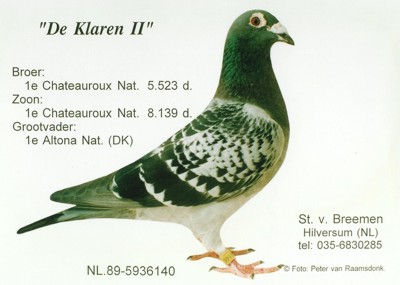Part 5
Faces and Eyes

This part in our series about breeding techniques deals with two very important characteristics which are very closely related to character: intelligence and speed.
A fancier tries to determine the degree of intelligence in a pigeon by observing its behavior in the loft and expression in its eyes. The shrewdness and ingenuity with which a pigeon is able to find independently its way back home, or with which it is able to adapt to changes in the weather are the signs of intelligence. When you look a pigeon in the face and you not only see the nose, but rather the whole face(this is also referred to as an "owl face") you are looking at a smart pigeon. It takes a bit of training before you get the hang of this, but after a while you notice how much you are able to tell about your feathered friends, by just looking at their faces and eyes.

"De Klaren II" is the son of the golden pair "De Goede Jaarling" and "Het Schoon Blauw". He is the grandfather of "Arne" the national Altona winner in Denmark for John Engel & Arne Porsmose. In 1989 "De Klaren II" was a member of the Dreamteam. The Dreamteam won in a hard race the first 11 positions from Orleans against 3000 birds. In the National all 11 birds finished in the top 22 prizes in a field of over 25.000 birds. In 1989 the Dreamteam won 4 weeks in a row the 1th prize in a provincial race against thousands!
The geneticist Prof. Alfons Anker once wrote a whole article on the subject. In condensed form this is what he said: if you mix ten class pigeons with a flock of ordinary birds and you line them up, sticking their heads through a hole in the wall, you very likely will be able to pick out most of the ten. But these class pigeons have to have real class! As I remembered Jan Aerts thought this to be exaggerated. Still there is a lot of truth in that story and I believe in it because it does deal with fundamental aspects.
There is something in the facial expressions of a class pigeon, which although unexplainable, is a definite character trade-mark; it is glowing with intelligence, fighting spirit, experience and mordant. It is next to impossible to try and explain the differences in expression. Every class pigeon represents his own unique qualities. In one bird, intelligence dominates in such a way that time after time he is able to find the shortest way home. In another pigeon something else dominates, like the amount of endurance, the willpower or the drive to fight on till the last breath to get back home. What I'm trying to explain here is that every class pigeon is in 'a class in itself', different from all others.
Continuing with this line of thought makes me realize that a high degree of intelligence and a large amount of perseverance is needed to turn an average pigeon into a class pigeon. Other qualities, such as muscles, body weight, vitality, etc. only promote the unfolding of a pigeon's class.
This last statement is an important one. Vitality can be discovered by close observation. The quality of the muscles can be determined by careful touch. But mordant and intelligence can only be detected from the facial expression of a pigeon or by its achievements. To be able to read the facial expression is something I'm not able to teach you. But there are many text books around: for example all the class pigeons themselves. Whenever possible take the opportunity to visit them and compare their facial expressions with those of ordinary pigeons. After a while you will get the hang of it.
Speed.
This quality presents itself in a wide range of variations: form a super fast pigeon way ahead of the rest, to the slow but consistent prize-winner. This quality is also transmitted intermediary (see previous article of meaning of this expression). The Janssen-type of pigeon is a very famous line that excels in speed. This quality is solidly grounded in the Janssen-type by inbreeding, and by qualitative-intermediary inheritance.
When cross-breeding with these types of pigeons the off-spring are always faster, or as fast, as the parents used for breeding. Plenty of evidence to prove this can be found in the international pigeon press. When we cross-breed two slow types of birds, we get pigeons who eventually show signs of exceptional vitality or the ability of 'being in shape' qualities, but they will never fly any faster.
In case we need to add speed tot the overall condition of our flock, we have to purchase birds who are faster than our own. But don't forget to take into account that the speed of pigeons is also influenced by other factors such as the shape of the wings and the disposition of the bird. But alone without the quality of speed, these will not suffice.
Talent for a certain distance.
This is a quality(which I almost forgot to mention although it certainly belongs to this chapter) is a typical representative again of Group Two and in many ways is tied to the quality of the muscles. The talent for a certain distance is a quality which is transmitted to the off-spring intermediary and inbreeding does have some influence on it.
In the next article we will talk about the muscles of a pigeon. Muscles can tell us to what degree a pigeon is able to perform, which makes this quality a very interesting one.
Steven van Breemen
Copyright 1998. All rights reserved. Reproduction in whole, in part, in any form or medium, without the express written permission of Steven van Breemen, is forbidden.
The whole book can be downloaded from "Winning Magazine" if you are a subscriber. You can subscribe here; costs 35 Euro for 1 year. You get 26 issues and have access to the archives with all previous published issues plus next to "The Art of Breeding" a second book written by me: "Hints for Mating, Breeding & Selection". A total bargain!
| 
